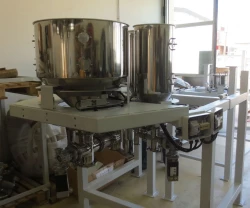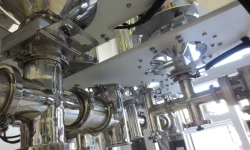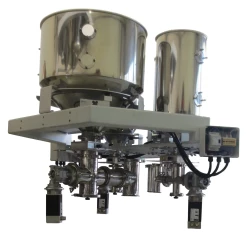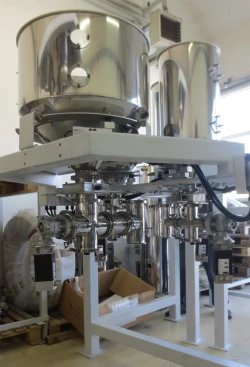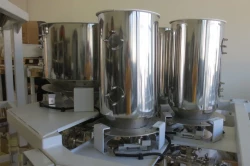Multi-Zone Volumetric and Gravimetric Dosing Stations for Plastics
series VDOS, WDOS
Multi_Zone volumetric Dosing Stations for plastics series V-DOS
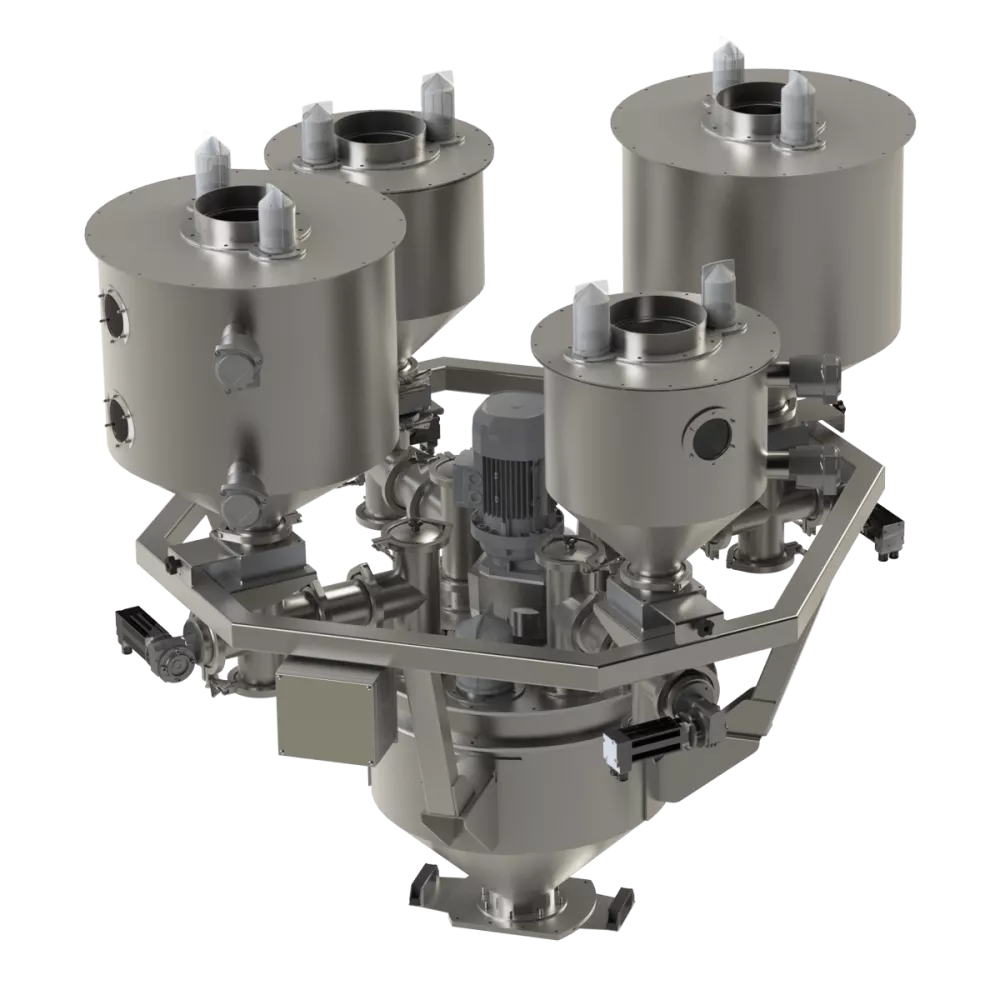
Multi_Zone gravimetric Dosing Stations for plastics series W-DOS
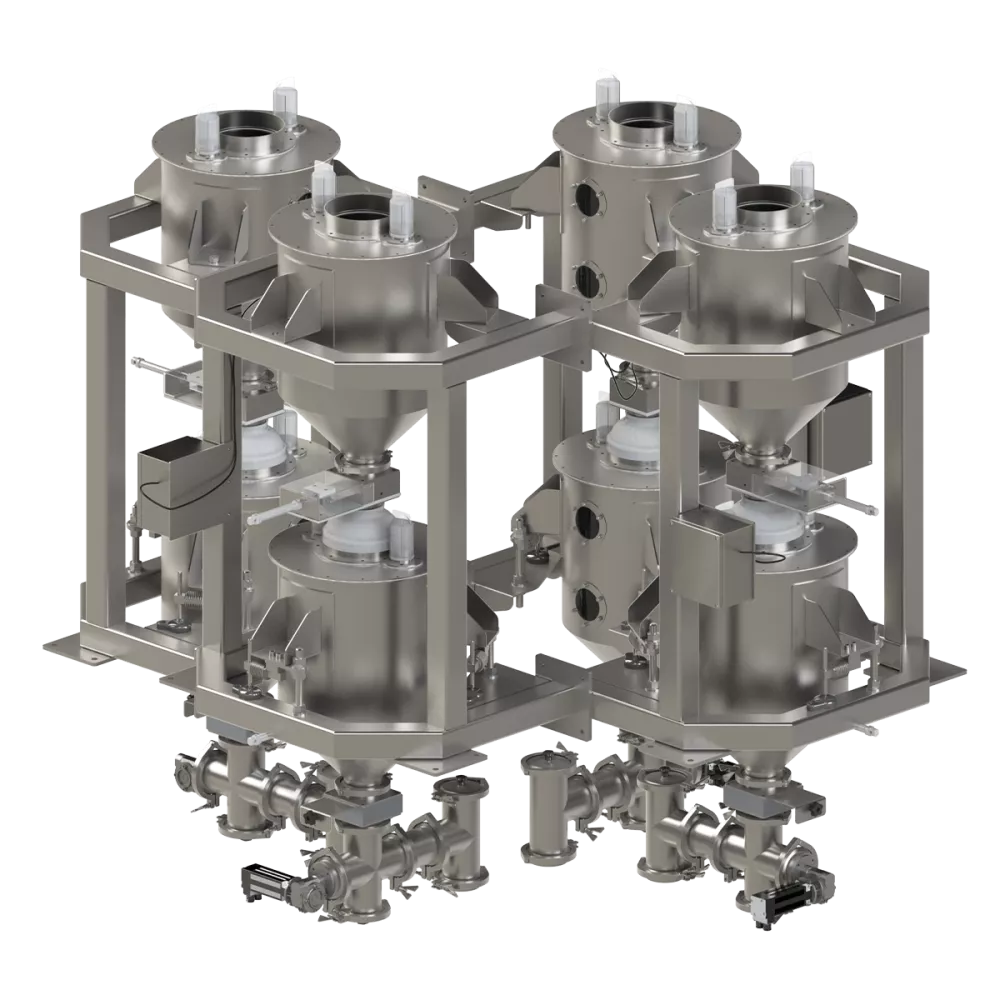
They are modular systems constituted by more dosing zones, each one dedicated to each ingredient of the recipe.
They are used to feed the extrusion lines in the plastic industry.
The setup VDOS is constituted by a set of volumetric dosers series G while the WDOS system has gravimetric dosers series GY.
The gravimetric doser GY is hung to load cells with its hopper properly equipped with supportive outer brackets. The load cells are off-center or flexion type, made in aluminium or in stainless steel with protection grade up to IP67, available also with Atex certification when requested.
The typical recipes of this specific sector do not provide the use of a number of ingredients higher than 6. Consequently the VDOS and WDOS stations provide maximum 6 dosing zones.
The products that can be dosed with the multi-zones stations VDOS and WDOS have the shape of granules, pellet or lentils with dimensions that vary from 1mm until 6-7 mm. These products are constituted mainly by thermoplastic polymers. Their characteristic is to be very free flowing and easy to dose, given their characteristics.
The dosers series G and GY of the stations VDOS and WDOS are equipped with dosing screw quite similar to the ones used in dosers for powders. Given the good flowing of the products, these dosers do not need agitators inside. Therefore their dimensions are particularly small also for high flow rates.
The multi-zones dosing stations VDOS, WDOS are not suitable to dose powder products, flakes or fibers that can often present flowability issues. For this kind of product it is suggested to use powder dosers series CH, CHW, CHY, BH, BHW ,BHY, DFV, DFW and DFY or flakes and fibers dosers series VF, VFW and VFY.
The most usual setup of the multi-zone stations VDOS and WDOS is the one so-called carousel, where the dosers are arranged in a circle and their outlets converge in the center where it is placed a conical collector.
Under the collector it can be installed a mixer to provide in all the cases where it is necessary to homogenize the product blend dosed to obtain a better dispersion of the minor ingredients or of the lighter ones.
The multi-zone dosing stations VDOS, WDOS can be installed directly on the extrusion lines or off line. In this specific case they can be dimensioned to feed even more than one extrusion line.
When the Multi-Zone system is installed on the extrusion line its collector, or the mixer, are placed directly on the inlet of the extrusion line.
In case the station is installed off line, proper transport systems are taken to transfer the product dosed.
The most used transport systems are pneumatic type. During the transport can occur product separations due to their different density and geometry. To make up for it, it is good to provide a mixing hopper (MXV) to be installed directly on the inlet of the extruder, suitable to receive the transported products. The mixing hopper (MXV) feeds the extruder with an homogeneous blend and with the right proportions of the vary ingredients. For the pneumatic transport it is possible to use vacuum loaders series ATS, AJS, ATSY and AJSY with the relative vacuum units series UATC, UATV and UAVL.
The outlet of the mixing hopper MXV is equipped with a slide gate that allows to hold the product inside the mixing chamber for a programmed residence time. This option is particularly suggested to avoid the dosed products and transferred at the beginning of the production to enter directly in the extruder without being properly mixed before. In the following conveying cycles it is the minimum level of the product in the mixing chamber to act as a barrier.
The mixing hopper MXV has level sensors that allow to automatically manage the conveying cycles. The most used sensors are capacitive types, rotary level sensors, vibrating level switches to choose according to the product characteristics.
The dosers G and GY installed in the Multi-Zone Stations have a compact design and construction. Their maintenance is simple and fast because they are constituted by triclamp fittings coupled together.
The range of dosers (G, GY) that compose the Multi-Zone Stations VDOS and WDOS is divided in sizes, to ensure a wide capacity range.
The entire range of dosers G and GY is constituted by 13 standard sizes in total that cover a capacity range from a minimum of 1 kg/h to a maximum of 5.000 kg/h.
The dosing device G and GY is designed to house dosing screws with different dimensions and shape and also interchangeable eachother thanks to a suitable plastic adapter .
The transmission group that move the dosing screw is constituted by a worm type gearbox and three-phase electric motor. In cases where a very wide throughput range is required ( the range between the minimum and maximum dosage capacity is more than 1 to 10) brushless type motors are used , that allow very slow rotation speed so as to achieve very small capacities.
The shaft mechanical seals are made with shielded bearings and dust tight rings available in different materials such as NBR, SILICONE, PTFE EPDM and VITON.
Atex certified motors are available eventually equipped with a temperature probe and an anti-condensation heating devices when it is requested.
The dosing screw motor can be controlled by a frequency converter, and can be eventually servoventilated. The brushless type motors are controlled by their specific digital servo-drive. Using these controlling devices it is possible to regulate the rotation speed of the dosing screw in order to obtain the wanted capacity in a predefined minimum and maximum range. The real achievable capacity range depends also on the characteristics of the product to dose. Using asynchronous motors generally it can be covered a range from 1 to 8 between minimum and maximum. The adjustment range can increase until 1 to 30 using brushless motors.
Ogni dosatore G e GY può essere dotato di opportuni scarichi verticali a “T” che vengono montati all’estremità della coclea per guidare il prodotto in caduta durante il dosaggio.
Vertical T spouts complete the set of this kind of dosers. They are mounted at the end of the front outlet tube to vertically guide the product falling down while dosing.
It is possible to combine with the dosers a wide variety of standard loading hoppers with different capacity.
The loading hoppers have normally a truncated conical, symmetrical or skewed shape. They have easily removable lids and a round loading inlet for the automatic refilling. Above the loading hoppers it can be eventually installed storage hoppers with automatic discharging valves that are cyclically actioned to provide the doser refilling.
Both the loading hoppers and the storage hoppers can be equipped with wide transparent polycarbonate sight glasses.
The storage hoppers can be manually or automatically supplied. In this last case the use of vacuum loaders series ATS and AJS is frequent. They are installed directly on the hopper lids with flange coupling.
As accessories of the hoppers there are level sensors, to detect the presence of product and allow the automatic refilling cycles. The most used sensors are capacitive types, rotary level sensors, vibrating level switches to choose according to the product characteristics.
The most used construction materials are stainless Aisi 304 and 316L. For the plastic adapter of the dosing screw are used materials such as HDPE, PTFE and ACETAL.
The dosing screws can be simply pickled or also mirror-polished. It is possible to have the certifications of the contact materials on request.
The outer surfaces are satined 180 mesh. It is possible to have them also glass bead blasted, electro-polished or mirror-polished on request.
The gaskets are made in dust-tight rubber , such as SBR or NBR. They are available also with FDA certification on request.
A self-supporting structure complete the setup of the Multi-Zone Stations VDOS and WDOS. It is dimensioned to house the dosers, their loading hoppers, the eventual storage hoppers with their vacuum loaders in order to form a compact and integrated system. The entire structure is sustained by uprights that allow to firmly anchor to the floor the entire Multi-Zone dosing station.
The construction materials used for the supporting structures are stainless steel Aisi 304 or varnished carbon steel.
Sometimes the entire Multi-Zone stations VDOS and WDOS are installed on a mezzanine, placed over the extruders and being integral part of an intermediate service floor, usually provided to house other machines for the line.
The logic functions of Multi-Zone Dosing Stations need to be necessary integrated with the one of the extrusion lines. About this can be also supplied electrical control panels including software specifically designed accordingly to the requested functionality.

